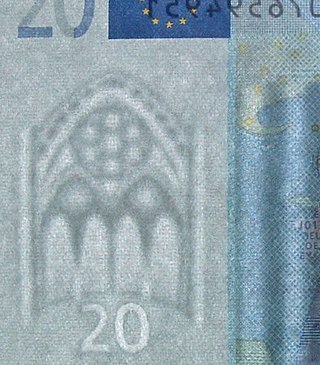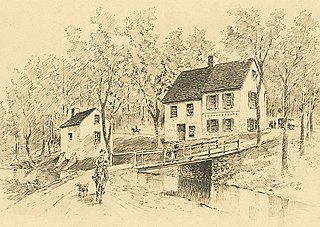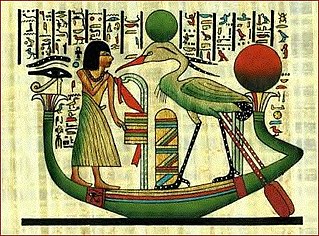
A watermark is an identifying image or pattern in paper that appears as various shades of lightness/darkness when viewed by transmitted light, caused by thickness or density variations in the paper. Watermarks have been used on postage stamps, currency, and other government documents to discourage counterfeiting. There are two main ways of producing watermarks in paper; the dandy roll process, and the more complex cylinder mould process.

The River Cray is the largest tributary of the River Darent. It is the prime river of outer, south-east Greater London, rising in Priory Gardens, Orpington, where rainwater percolates through the chalk bedrock of the Downs to form a pond where the eroded ground elevation gives way to impermeable clay. Initially it flows true to form northwards, past industrial and residential St Mary Cray, through St Paul's Cray and through Foots Cray, where it enters the parkland Foots Cray Meadows, flowing under by Five Arches bridge. It then flows by restored Loring Hall (c.1760), home of the Lord Castlereagh who killed himself there in 1822. It continues through North Cray and Bexley. It neighbours a restored Gothic (architecture) cold plunge bath house, built around 1766 as part of Vale Mascal Estate. It is then joined by the River Shuttle and then continues through the parkland of Hall Place, which was built for John Champneys in 1540. The Cray turns eastward through Crayford and Barnes Cray to join the Darent in Dartford Creek. The Creek is a well-watered partly tidal inlet between Crayford Marshes and Dartford Marshes by a slight projection of land, Crayford Ness. The villages through which the Cray flows are collectively known as "The Crays".

The Darent is a Kentish tributary of the River Thames and takes the waters of the River Cray as a tributary in the tidal portion of the Darent near Crayford. 'Darenth' is frequently found in the spelling of the river's name in older books and maps, Bartholomew's "Canal's and River of England" being one example. Bartholomew's Gazetteer (1954) demonstrates that Darent means "clear water", a result of it springing from and running through chalk. The purity of the water was a major factor in the development of paper and pharmaceuticals in the area.

Greenhithe is a village in the Borough of Dartford in Kent, England, and the civil parish of Swanscombe and Greenhithe. It is located 4 miles east of Dartford and 5 miles west of Gravesend.

Dartford is the principal town in the Borough of Dartford, Kent, England. It is located 18 mi (29 km) south-east of Central London and is situated adjacent to the London Borough of Bexley to its west. To its north, across the Thames estuary, is Thurrock in Essex, which can be reached via the Dartford Crossing. To its east lies the Borough of Gravesham and to the south the district of Sevenoaks.

Wove paper is a type of paper first created centuries ago in the Orient, and subsequently introduced to England, Europe and the American colonies in the mid-eighteenth century. Hand-made wove paper was first produced by using a wooden mould that contained a finely-woven brass vellum, upon which the paper pulp was applied and dried, creating a smooth, uniform surface.

Ruxley was an ancient hundred, a land division in the north west of the county of Kent, England. Its area has been mostly absorbed by the growth of London; with its name currently referring to the Ruxley district. Its former area now corresponds to a majority of the London Borough of Bromley, a large part of the London Borough of Bexley and a small part of the Kent District of Sevenoaks. The hundred was within the Lathe of Sutton-at-Hone, in the west division of Kent.

Charles Kent was a British-American stage actor and silent film actor and director. He appeared in more than 140 films between 1908 and 1923. He also directed 36 films between 1908 and 1913.

Joseph C. Gayetty was an American inventor credited with the invention of commercial toilet paper. It was the first and remained only one of the few commercial toilet papers from 1857 to 1890 remaining in common use until the invention of splinter-free toilet paper in 1935 by the Northern Tissue Company.

William Rittenhouse was an American papermaker and businessman. He served as an apprentice papermaker in the Netherlands and, after moving to the Pennsylvania Colony, established the first paper mill in the North American colonies, helping to meet the growing demand for paper among the Early American publishers and printers. Rittenhouse was also the first Mennonite bishop in America. Along with his two sons, and their descendants, the Rittenhouse family maintained a papermaking business in Pennsylvania for well over one hundred years. The site of the original mill is now preserved as the Historic RittenhouseTown district of Philadelphia.
Sir John Spilman was a Lindau, German-born entrepreneur who founded the first commercially successful paper-mill in England, establishing a factory on the River Darenth in Dartford, Kent in 1588. Spilman was also jeweller to Queen Elizabeth I, and was knighted by King James I.
Whatman plc is a Cytiva brand specialising in laboratory filtration products and separation technologies.

James Whatman (1702–1759), the Elder, was a paper maker, born in Kent, who made revolutionary advances to the craft in England. He is noted as the inventor of wove paper, an innovation used for high-quality art and printing. The techniques continued to be developed by his son, James Whatman the Younger (1741–1798). At a time when the craft was based in smaller paper mills, his innovations led to the large scale and widespread industrialisation of paper manufacturing.
Conqueror is a manufacturer of distinctive, high-quality watermarked paper in the United Kingdom. The company was founded in the late 1880s by E.P. Barlow, director of the London-based stationer Wiggins Teape.
William Algernon Churchill was an art historian and British diplomat.
Clement Taylor, of Tovil House, Maidstone, Kent, was an English paper-maker and politician who sat in the House of Commons from 1780 to 1796.

Watercolor paper is paper or substrate onto which an artist applies watercolor paints, pigments, or dyes. Artists generally no longer use stone or tomb walls as a substrates. Many types of watercolour papers that are manufactured for the use of watercolors are currently available. Watercolor paper can be made of wood pulp exclusively, or mixed with cotton fibers. Pure cotton watercolor paper is also used by artists, though it typically costs more than pulp-based paper. It is also available as an acid-free medium to help its preservation.
St Cuthberts Mill is a British paper manufacturing company in Wells, Somerset, that specialises in mould made artists papers. The range includes traditional painting and printmaking papers, and inkjet papers.
John Hall was an English millwright and mechanical engineer, who, in 1785, founded the Dartford-based engineering company which became J & E Hall, today a prominent supplier of refrigeration machinery, and part of the Daikin group. During Hall's lifetime, he helped mechanise the papermaking industry, co-founded the first UK canning firm, and developed steam engines for land and marine use.
Matthew Towgood IV (1760/1–1830) was an English banker and industrialist, from about 1808 proprietor of a paper mill near St Neots, then in Huntingdonshire.












